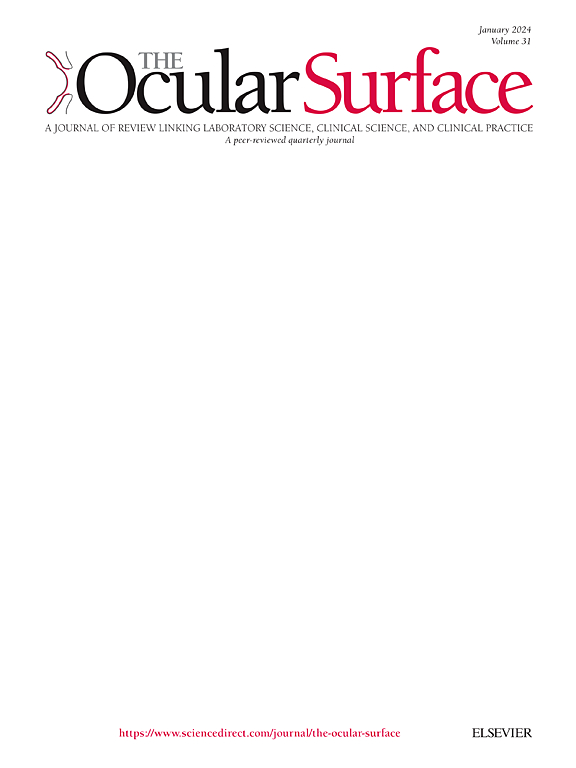Development and optimization of an ex vivo model of corneal epithelium damage with 1-heptanol: Investigating the influence of donor clinical parameters and MSC-sEV treatment on healing capacity
IF 5.6
1区 医学
Q1 OPHTHALMOLOGY
引用次数: 0
Abstract
Purpose
To develop and characterize a reproducible human corneal epithelial wound-healing model using 1-heptanol, and to investigate the healing potential of Bone Marrow-derived Mesenchymal Stromal Cell small Extracellular Vesicles (MSC-sEV) and the influence of donor characteristics on epithelial healing.
Methods
Eighty-eight (n = 88) human corneoscleral tissues unsuitable for transplantation were employed. Corneal epithelial damage was induced with 1-heptanol and monitored every 24 h up to 96 h using fluorescein and trypan blue staining. Histological assessment was performed on untreated and damaged tissues. Damaged areas were measured with FIJI software, and healing rates were calculated. MSC-sEV were isolated with size exclusion chromatography and characterized for their size, morphology and biomarkers. Their impact on healing was assessed in both in vitro scratch assays on cultured human corneal epithelial cells and on ex vivo 1-heptanol-damaged corneas.
Results
Histological analysis revealed detached corneal epithelium in the central area, while other layers remained unaffected. Healing rate peaked at 48 h post-damage. Trypan blue and Fluorescein staining correlated and the former highlighted a higher initial healing rate than the latter. Diabetic and heart-beating brain-deceased donors showed impaired healing rates. MSC-sEV (79.8 nm, spherical bilayer, positive for TSG101, CD9, CD63, and CD81) significantly improved epithelial wound healing in both in vitro and ex vivo models.
Conclusion
1-heptanol effectively induces reproducible corneal epithelial damage, and the ex vivo organ-cultured human cornea heals the epithelium within 96 h. Diabetes and donation from heart-beating brain-deceased donors reduce healing capacity. MSC-sEV boost epithelial repair in damaged corneas.
1-庚醇角膜上皮损伤离体模型的建立与优化:研究供体临床参数和MSC-sEV治疗对愈合能力的影响
目的:利用1-庚醇建立可复制的人角膜上皮细胞创面愈合模型并对其进行表征,探讨骨髓间充质基质细胞小胞外囊泡(MSC-sEV)的愈合潜力以及供体特征对上皮愈合的影响。方法:采用88例不适合移植的人角膜巩膜组织。用1-庚醇诱导角膜上皮损伤,每24小时监测一次,直至96小时用荧光素和台盼蓝染色。对未处理和受损组织进行组织学评估。用斐济软件测量损伤面积,计算愈合率。采用大小排斥色谱法分离MSC-sEV,并对其大小、形态和生物标志物进行了表征。在培养的人角膜上皮细胞和离体1-庚醇损伤的角膜的体外划伤实验中,评估了它们对愈合的影响。结果:组织学分析显示角膜中央区角膜上皮脱落,而其他层未受影响。愈合率在伤害后48小时达到峰值。台盼蓝染色与荧光素染色相关,前者的初始愈合率高于后者。糖尿病患者和心脏跳动的脑死亡捐赠者的治愈率受损。mscs - sev (79.8 nm,球形双层,TSG101, CD9, CD63和CD81阳性)在体外和离体模型中均显著改善上皮伤口愈合。结论:1-庚醇能有效诱导可复制性角膜上皮损伤,体外器官培养的人角膜可在96小时内愈合。糖尿病和心脏跳动的脑死亡捐赠者的捐赠会降低治疗能力。MSC-sEV促进受损角膜上皮修复。
本文章由计算机程序翻译,如有差异,请以英文原文为准。
求助全文
约1分钟内获得全文
求助全文
来源期刊

Ocular Surface
医学-眼科学
CiteScore
11.60
自引率
14.10%
发文量
97
审稿时长
39 days
期刊介绍:
The Ocular Surface, a quarterly, a peer-reviewed journal, is an authoritative resource that integrates and interprets major findings in diverse fields related to the ocular surface, including ophthalmology, optometry, genetics, molecular biology, pharmacology, immunology, infectious disease, and epidemiology. Its critical review articles cover the most current knowledge on medical and surgical management of ocular surface pathology, new understandings of ocular surface physiology, the meaning of recent discoveries on how the ocular surface responds to injury and disease, and updates on drug and device development. The journal also publishes select original research reports and articles describing cutting-edge techniques and technology in the field.
Benefits to authors
We also provide many author benefits, such as free PDFs, a liberal copyright policy, special discounts on Elsevier publications and much more. Please click here for more information on our author services.
Please see our Guide for Authors for information on article submission. If you require any further information or help, please visit our Support Center
 求助内容:
求助内容: 应助结果提醒方式:
应助结果提醒方式:


